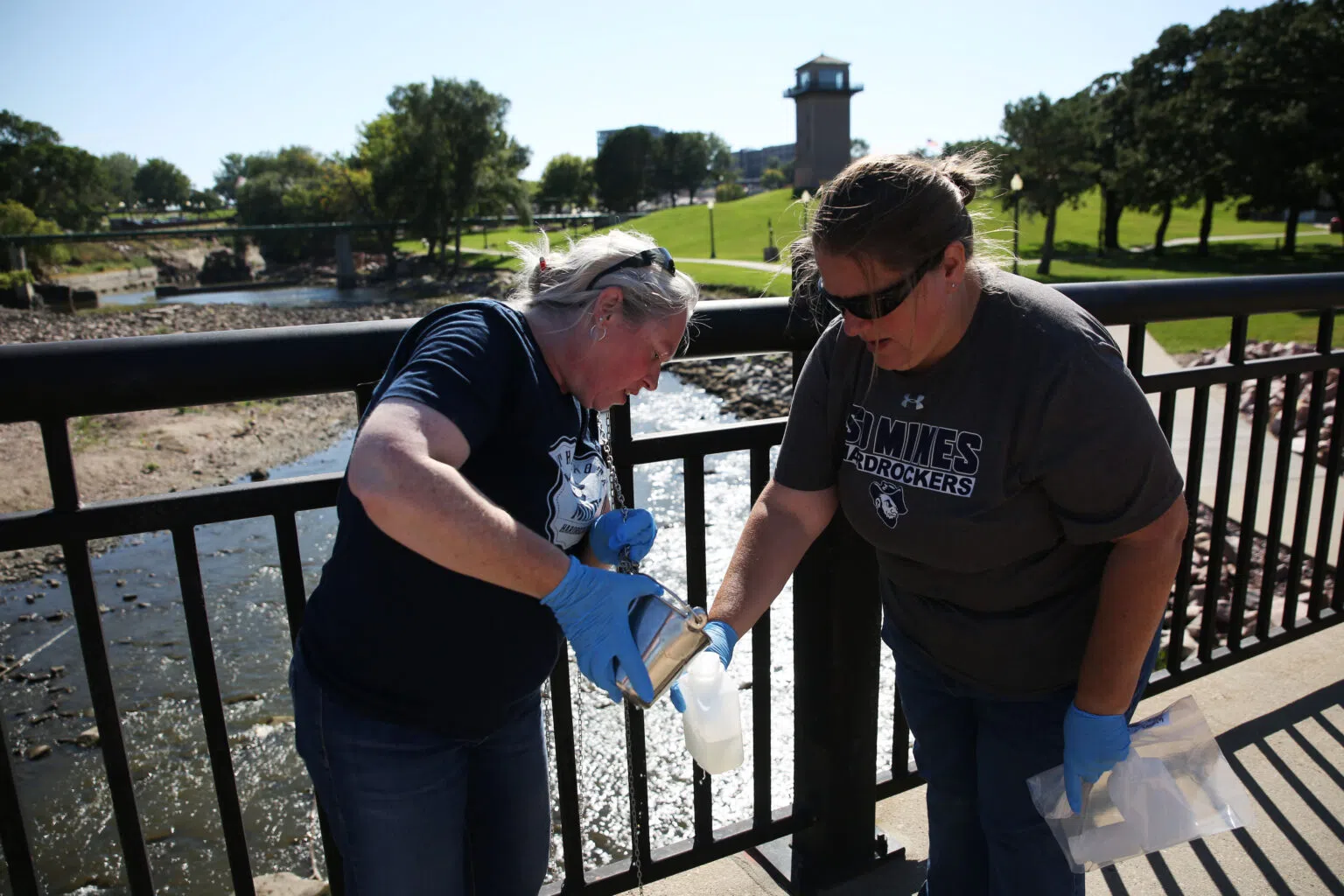
Jenny Kozak (left), a master’s student at South Dakota Mines, pours Big Sioux River water into a collection bottle held by South Dakota Mines Associate Professor Lisa Kunza on Sept. 26 at Falls Park in Sioux Falls. (Makenzie Huber/South Dakota Searchlight)
By: Makenzie Huber
SIOUX FALLS, S.D. (South Dakota Searchlight) — Preliminary sampling data identified “forever chemicals” in the Big Sioux River in eastern South Dakota, flagging water sampled at Falls Park in Sioux Falls as a hotspot.
The study, conducted by East Dakota Water Development District and South Dakota Mines, tested water for per- and polyfluoroalkyl substances (PFAS) at 11 sites from northeast South Dakota to the Iowa border past Sioux Falls in September. The sampling is the first of five runs and more testing is required to draw conclusions of PFAS contamination levels in the river.
The chemicals have been used in industry and consumer products since the 1940s and don’t break down easily in the environment or in the human body. Research indicates PFAS exposure may be linked to negative developmental and reproductive effects, and an increased risk of some cancers.
The federal government finalized limits on some types of PFAS in drinking water earlier this year. Those limits apply specifically to treated drinking water and will be implemented in phases.
Although the maximum contaminant levels don’t apply to surface water, public drinking water systems located near the river should be aware of it, said Jay Gilbertson, district manager. An ongoing study indicates that, under the right conditions, Big Sioux River water can infiltrate wells near the river.
Researchers found 32 detections representing nine types of PFAS compounds. They detected one or more PFAS compounds at nine of the 11 sites, all below Watertown.
At Falls Park, researchers found amounts of a PFAS tied most commonly to firefighting foams at 30 parts per trillion — over seven times the U.S. Environmental Protection Agency limits for treated drinking water. Researchers found PFAS compounds at the site totaling more than 80 parts per trillion, which was the highest concentration detected.

PFAS was previously detected in wells near Ellsworth Air Force Base at Box Elder, as well as Sioux Falls Regional Airport and its co-located Air National Guard base, where the chemicals were used in firefighting foam. The forever chemical was also detected in wells at National Guard facilities near Custer and in Rapid City, and in three private wells in South Dakota.
Sioux Falls suspended 21 of its wells suspected of PFAS contamination after those earlier detections. Since then, all raw water samples — which can include the Big Sioux River at times — have been tested for PFAS compounds. The city has not detected PFAS in those sources.
“We’re accumulating PFAS from one source or another,” said Lisa Kunza, associate professor in chemistry, biology and health sciences and director of the Center for Sustainable Solutions at South Dakota Mines in Rapid City.

The Big Sioux River is diverted above Sioux Falls, the main channel loops through the city before joining the diverted water again. Skunk Creek also pours into the Big Sioux River within the loop, which researchers didn’t test. East Dakota board member Bob Kappel reminded the board of above-ground gasoline tank leaks in western Sioux Falls near Skunk Creek in 1986, which led to the closure of Hayward Elementary School and may have contaminated the creek with PFAS, he said.
A testing site just below Watertown reported the second highest concentration of PFAS compounds at just under 40 parts per trillion. All other sites between Watertown and Sioux Falls reported less than 20 parts per trillion, according to the data.
At the testing site below Falls Park, where the Big Sioux loop meets with water diverted around the city and water discharged from the city’s wastewater treatment plant, concentrations of the two compounds dropped significantly due to dilution, Gilbertson said. Though, the levels were above the “very modest amounts” found at sites before running through Sioux Falls.
The Big Sioux River at the time of sampling was in the middle of a months-long drought, and its flow rate was significantly slower than normal — likely making the levels of contamination more pronounced, Kappel said. He encouraged the board to consider testing at more normal flow rates in the future.

Either way, something is contaminating the Big Sioux River in Sioux Falls, leading to elevated PFAS levels in the water even after dilution from diverted water, Gilbertson said.
Gilbertson told the board he plans to conduct follow-up sampling around Sioux Falls in the coming weeks. He also wants to add two to four sampling sites around the Sioux Falls area for future sampling next year. That would allow the board to glean more information about where the contaminants come from.
“Our current detections tell us that South Dakota is no different than anywhere else,” Gilbertson said in a memo to board members. “PFAS compounds are being found in many, many places, and the sooner we look for them, the sooner we can start planning for how to deal with them.”




Comments